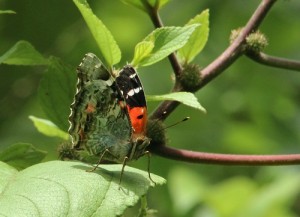Brilliant orange and fluttering through the forest, the Kamehameha butterfly, or pulelehua, is our state insect. It’s one of only two butterfly species native to Hawaiʻi, and its ancestors flew to these Islands long before the first humans stepped ashore.

Knowing māmaki is in your area can cue you in to looking for Kamehameha butterflies. Photo by Forest and Kim Starr
“A lot of butterflies could have arrived here,” says University of Hawaiʻi researcher Will Haines. “But unless they could find a host plant they died.” The Kamehameha butterfly’s ancestors had suitable hosts: Hawaiian māmaki and other close relatives in the nettle family. The pulelehua caterpillars feed only on these native plants, once common throughout the Islands. But as humans transformed forests into fields and pastures, and invasive species spread from backyards, the māmaki, olonā, and ōpuhe plants became scarce. As this caterpillar food became less common at lower elevations, so did the Kamehameha butterfly. Today, any low-elevation populations of the butterfly depend on the scattered māmaki plants found in gulches, and this endemic butterfly is mostly found in the native forests higher in the mountains where food is more plentiful.

The ancestors of the Kamehameha butterfly found a food source in māmaki and related plants in the nettle family. Photo by Nathan Yuen
But thanks to an exciting citizen science activity, the Pulelehua Project, researchers are discovering that the Kamehameha butterfly is fluttering around in surprising places. Like a community on the North Shore of Oʻahu and a backyard in Kēōkea on Maui. “This butterfly is a strong flyer – it seems to be cruising through,” says Haines.
The Pulelehua Project emerged out of Haines’ research. With funding from the State of Hawaiʻi Department of Land and Natural Resources, Division of Forestry and Wildlife, Haines has been investigating various threats to the species’ survival in the field and mapping the Kamehameha butterfly’s distribution throughout the state. Mapping butterflies across the archipelago is a big job; Haines thought others may be interested in helping.
Kamehameha butterflies are charismatic and relatively easy to recognize, so Haines started contacting other conservation groups for help for help. He created a website, www.kamehamehabutterfly.com, filled with resources to help amateur entomologists identify the species in its different and fascinating life stages, from tiny urchin-shell like eggs to colorful adults. The website has excellent photographs of the eggs, caterpillars, adults, and their favored host plants. Butterfly lovers across the state volunteered– reports came in from conservationists and the public alike.

The Kamehameha butterfly can be recognized by the pattern of white or light patches on the upper surface of the forewings. Pulelehua has only three main white patches in this area (though some are divided by dark wing veins). Look-alike butterflies have more white spots. Photo by Nathan Yuen
To date, the reports have turned up 52 confirmed sightings of the iconic state insect. Anyone can participate and reports can be recent sightings or several years old, so long as there is a photo to accompany the information about when and where the butterfly, caterpillar, egg, or even feeding damage was observed. The data collected from the mapping project will help Haines and his colleagues better estimate the distribution of the pulelehua and could shape efforts to restore habitat for the Kamehameha butterfly.
The project is ongoing and you can help. Checking a māmaki patch is a good place to start. If you have māmaki in your area, or find māmaki while out hiking, inspect the leaves for eggs, caterpillars, and even feeding damage, and submit a report.

Caterpillars of the Kamehameha butterfly can be several different colors, from green to brown, but always covered in spines and bumps. Photo by Will Haines.
Use the photos on the website to make sure you’ve got the right butterfly. At one time, the Kamehameha butterfly was the only pair of orange wings around, but now, painted ladies, red admirals, monarchs, and gulf fritillary all flit through Hawaiʻi yards and forests. These exotic species, which can easily be confused with adult pulelehua, do not seem to pose a threat to the native butterfly. Other insects do. Ants, and potentially the little fire ant to a greater degree, can prey on caterpillars and the pupa in the chrysalis. Introduced katydids have an appetite for butterfly eggs. And, as the caterpillars of Kamehameha butterfly don’t dine on introduced nettles, it’s critical to protect their native food source.

The caterpillars create a distinctive pattern as the munch māmaki leaves. This distinct pattern can bu used to document the presence of the Kamehameha butterfly. Photo by Will Haines
These are all reasons to take your butterfly-hunting habit to the next level. To attract the Kamehameha butterfly to your yard, plant māmaki and encourage your neighbors to do the same. A single plant can support ten caterpillars, but according to Haines, it’s more about establishing a critical mass of māmaki across the landscape. Physical barriers, like tanglefoot, a tacky substance designed to keep crawling critters from climbing up plants, can protect eggs and caterpillars from ants and other predatory insects. Learn more about the Pulelehua Project and submit sightings at www.kamehamehabutterfly.com.
Lissa Strohecker is the public relations and education specialist for the Maui Invasive Species Committee. She holds a biological sciences degree from Montana State University. Kia’i Moku, “Guarding the Island,” is prepared by the Maui Invasive Species Committee to provide information on protecting the island from invasive plants and animals that can threaten the island’s environment, economy and quality of life.
Originally published in the Maui News, June 14th, 2015 as part of the Kia‘i Moku Column from the Maui Invasive Species Committee.


